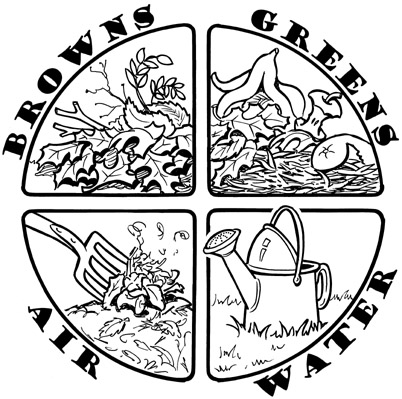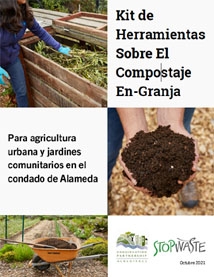Backyard Composting
 The microorganisms that break down organic material in your soil will happily do the same job in a compost bin. Your role as a composter is to provide the conditions for nature's crew of decomposers—the bacteria, fungi, and bigger creatures such as sow bugs and worms—to go to work. Browns, Greens, Air and Water are the "big four" that will keep every compost pile happy. We have some basic information about making compost below, for more details check out our Tools for Building Healthy Soil guide.
The microorganisms that break down organic material in your soil will happily do the same job in a compost bin. Your role as a composter is to provide the conditions for nature's crew of decomposers—the bacteria, fungi, and bigger creatures such as sow bugs and worms—to go to work. Browns, Greens, Air and Water are the "big four" that will keep every compost pile happy. We have some basic information about making compost below, for more details check out our Tools for Building Healthy Soil guide.
Directions for making compost:
This recipe works for mixing food scraps and yard trimmings together, and requires a rodent-resistant compost bin and active maintenance to prevent animal nesting and feeding.
-
Feed yard trimmings to your bin as you generate them by chopping them first into pieces 6” or smaller.
-
Food scraps need to be buried and mixed into the center of the pile.
-
Learn what you can put in your compost bin, click here.
-
Feed as often as you like but be sure to mix in enough browns to balance your greens, and always top with browns (never dump food and run!).
-
Maintain compost by turning or mixing it about once a week, and keep it as moist as a wrung-out sponge.
-
Harvest rich, brown, finished compost by sifting out coarse, unfinished materials after 3 to 8 months.
-
Get more helpful tips by checking out our Troubleshooting Your Backyard Bin, and FAQ Backyard Composting pages.
How can you tell when compost is done?
-
It will look like soil and smell sweet and earthy.
-
The volume of the pile will shrink by 30-50 percent.
-
The original materials will be unrecognizable, except some woody pieces.
Storing compost
We recommend “aging” your compost by letting it sit for six months before using.
- Cover with a tarp or keep in a sheltered space to protect from the rain and sun.
- Remove the tarp periodically to provide air.
NOTE: If unfinished compost is added to your soil, the decomposer organisms compete with plants for nitrogen, resulting in stunted plant growth and yellow leaves.
Related Resources
Learn more about building healthy soil with this guide that provides tips to help you get started in your garden. It covers soil building strategies including composting, sheet mulching and cover cropping.
This in-depth guide can answer all of your compost questions. Whether you are an urban farmer, community gardener, or a backyard homesteader, this toolkit supports you in becoming an expert composter.

El objetivo de este kit de herramientas es proporcionar un enfoque práctico paso a paso para los agricultores urbanos de cualquier escala para comenzar el compostaje en la granja agrícola, evaluar y mejorar el sistema existente, y convertirse en maestros compostadores.
How-to Compost
This video presents the basics about what to put in your bin, and how to build and maintain a compost pile.